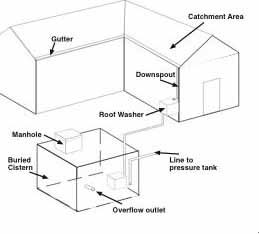

Alternatively, if the soils are not well suited for drainage, a cistern can be employed. Not common to Vermont, this technology is frequently used in the tropics and arid areas. A tank retains the water generated from roof runoff. Collected water can then be pumped out for non-potable applications. From an energy perspective, a cistern placed above ground level could benefit from the force of gravity for lawn or gardening watering, which would reduce the energy load. Alternatively, the tank can be placed below ground level and pumped as needed.

Up front costs including installation, engineering, and pumping infrastructure vary with location. Synthetic water tanks holding up to 2000 gallons cost between $0.45 and $1.00 per gallon of storage; concrete tanks are more expensive.
The advantage of this technology is that cisterns can be sized for 100% of stormwater capture and they allow for automated management. It is also possible to scale this technology for a cluster of homes or sections of roadway.
This technology manages stormwater volume but does not treat pollutants. However, there are hybrid variations of this technology which include the use of plants for nutrient uptake. (See next page.)
For more information, check The Montana AG Extension
Drawing credit: Montana Ag Extension